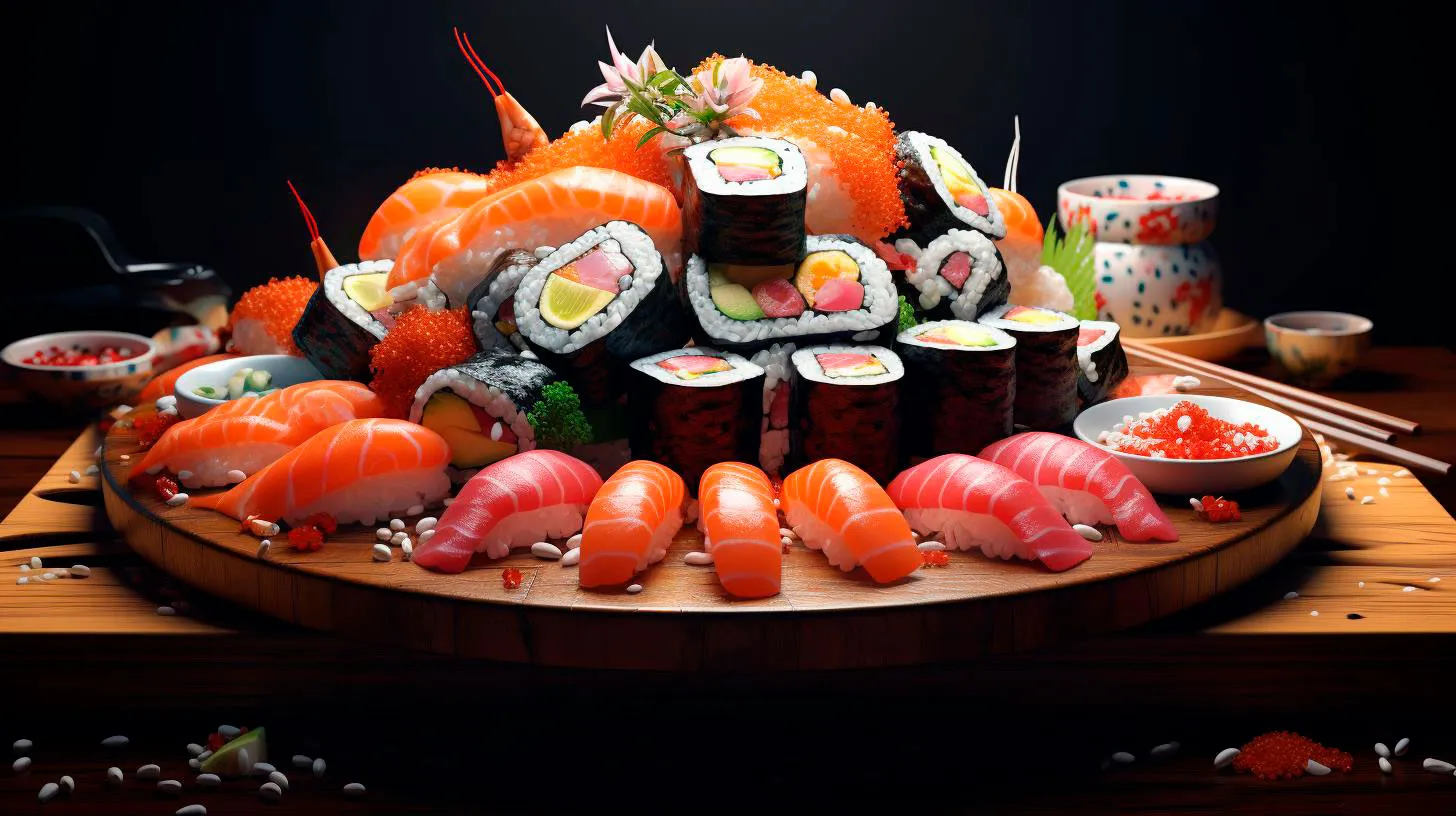Sushi Restaurants: A Profitable Industry with Growing Competition
Sushi restaurants have seen unprecedented growth, with customers embracing this cultural delicacy in various corners of the globe. However, along with the rising popularity comes increasing competition among sushi restaurants. In this article, we will explore the profitability of the sushi industry, analyze the growing competition, and discuss strategies to stay ahead in this lucrative domain.
Industry Overview:
Sushi restaurants have emerged as a booming industry globally. According to a recent report by Allied Market Research, the global sushi restaurants market is expected to reach $22.2 billion by 2026, growing at a CAGR of 10.7% between 2019 and 2026. The increasing demand for healthy and exotic food choices, coupled with the growing popularity of Japanese cuisine, is driving this remarkable growth.
The Rising Competition:
As the sushi industry continues to flourish, competition among sushi restaurants is becoming more intense. To keep up with the demand and win the hearts of customers, restaurant owners and managers need to adopt innovative strategies. Here are a few key factors contributing to the growing competition:
- Expanding market presence: Sushi restaurants have now become a common sight in many cities and towns. With an increasing number of players, there is fierce competition to attract and retain customers.
- Customer expectations: Diners today have higher expectations when it comes to the quality of the sushi, presentation, and overall dining experience. Meeting and surpassing these expectations is crucial to staying ahead in the race.
- Modernization and technology: Technology has revolutionized the restaurant industry, and sushi establishments are no exception. Restaurants that leverage technology to enhance customer convenience and streamline operations gain a competitive edge.
- Online and delivery services: The rise of online platforms and food delivery services has changed the landscape of the restaurant industry. To remain competitive, sushi establishments need to adapt to these trends and offer online ordering and delivery services.
Key Strategies to Thrive:
To stand out in a crowded market and thrive in the sushi industry, sushi restaurant owners can adopt the following strategies:
- Maintain quality and freshness: Invest in sourcing the finest ingredients and ensure high-quality sushi offerings to provide an exceptional dining experience. Freshness should be a top priority.
- Innovative menu offerings: Continuously innovate and introduce new, exciting sushi options to keep customers engaged. Experimenting with fusion flavors, vegetarian options, and creative rolls can differentiate your restaurant from competitors.
- Superior customer service: Train staff to provide excellent customer service. Prompt service, attentive staff, and personalized experiences can enhance customer satisfaction and loyalty.
- Embrace technology: Embrace online ordering systems, mobile apps, and reservation platforms to offer a seamless dining experience. Utilize social media platforms to engage with customers and showcase your unique offerings.
- Collaborations and partnerships: Partner with local suppliers, breweries, or even influencers to create unique collaborations. These partnerships can help expand your customer base and generate buzz around your restaurant.
- Localized marketing campaigns: Tailor marketing efforts to target the local audience. Leverage platforms like Google My Business and online directories to improve your visibility.
Conclusion:
The sushi restaurant industry is a flourishing market, but the growing competition makes it imperative for businesses to stay ahead of the curve. By focusing on delivering high-quality sushi, utilizing technology, and providing excellent customer service, sushi restaurants can thrive and secure their place in this profitable industry. Embracing innovation, staying attuned to customer preferences, and constantly evolving will enable sushi restaurants to remain profitable and relevant even in the face of growing competition.
Key Takeaways:
- The global sushi restaurants market is projected to reach $22.2 billion by 2026, growing at a CAGR of 10.7%.
- The intense competition in the sushi industry is driven by factors such as expanding market presence, increasing customer expectations, and advancements in technology.
- To thrive in the industry, sushi restaurants should prioritize maintaining quality and freshness, offer innovative menu options, provide superior customer service, embrace technology, and focus on localized marketing campaigns.
Fish Market Ecosystem Supply and Demand for Sushi
In this article, we will delve into the fascinating fish market ecosystem and explore the supply and demand dynamics that drive the sushi industry.
Supply Side of the Fish Market Ecosystem
The journey of fish from water to plate involves a complex supply chain with various components. Understanding these components helps us appreciate the effort that goes into delivering fresh fish to sushi lovers. Let’s break down the supply side of the fish market ecosystem:
1. Fishing Industry:
The fishing industry plays a pivotal role in the supply of fish for the market. Both commercial fishing fleets and small-scale fishermen contribute to meet the demand for sushi-grade fish. With sustainable fishing practices gaining traction, it is essential for fishermen to adhere to regulations to ensure the longevity of fish populations.
2. Fish Wholesalers:
Once caught, fish are transported to wholesalers who act as intermediaries between fishermen and sushi restaurants. Wholesalers keep the fish fresh by carefully handling, processing, and storing them in controlled environments. They also ensure that the fish meet the quality standards set by sushi restaurants.
3. Auctions:
Many fish markets, such as the famous Tsukiji Fish Market in Tokyo, hold auctions where wholesalers purchase fish directly from fishermen. These auctions determine the price of different fish species based on factors like size, freshness, and demand. The competition among wholesalers can be intense, driving prices up for popular sushi fish like tuna.
4. Distribution:
After purchasing fish at auctions or from wholesalers, distributors transport the fish to sushi restaurants and other seafood-related businesses. Maintaining proper storage and temperature during transportation is critical to preserve the freshness and quality of the fish.
Demand Side of the Fish Market Ecosystem
On the demand side, sushi lovers, including both local customers and tourists, are the driving force behind the fish market ecosystem. The increasing popularity of sushi has led to a surge in demand for sushi-grade fish. Let’s explore some key factors on the demand side:
1. Sushi Restaurants:
Sushi restaurants are the primary buyers of sushi-grade fish. To meet the expectations of their customers, sushi chefs strive to source the freshest fish available. Building strong relationships with wholesalers and participating in fish auctions enable sushi restaurants to secure the best quality fish consistently.
2. Consumer Preferences:
The preferences of sushi consumers significantly impact the demand for different types of fish. For example, the demand for fatty tuna, known as toro, has increased due to its rich flavor and smooth texture. Additionally, consumers are increasingly conscious of sustainable seafood choices, leading to a rise in demand for responsibly sourced fish.
3. Tourism:
Tourism plays a crucial role in boosting the demand for sushi. Many tourists view sushi as a quintessential Japanese culinary experience and make it a point to try sushi during their visit. Popular tourist destinations often witness a surge in sushi demand, both within local restaurants and at dedicated sushi markets.
Advantages and Key Takeaways
The fish market ecosystem is essential for the sustained supply of high-quality fish to sushi restaurants. Understanding this ecosystem empowers sushi lovers, chefs, and business owners to make informed decisions. Here are some key advantages and takeaways:
- Conservation efforts are vital to maintain fish populations and ensure their availability in the market.
- Strong relationships between sushi restaurants and wholesalers enable better sourcing and consistent quality.
- Sustainable seafood choices are gaining popularity, contributing to responsible fishing practices.
- Fish auctions are exciting events that influence the price and availability of sushi-grade fish.
By acknowledging the intricate supply and demand dynamics of the fish market ecosystem, we gain a deeper appreciation for the artistry and dedication involved in producing excellent sushi. Next time you indulge in a delicious sushi roll, you can savor not only the flavors but also the fascinating journey that brought that fish to your plate.
The Rise of Sushi: A Global Culinary Phenomenon
Let’s delve into the rise of sushi as a global culinary phenomenon and explore what makes it so special.
The Origins of Sushi
Sushi, as we know it today, traces its roots back to Japan in the seventh century. Originally, sushi was a way of preserving fish by fermenting it with rice. Over time, it evolved into the delicacy we enjoy today. The key to sushi’s success lies in its simplicity and balance of flavors.
The real turning point for sushi, however, came in the early 19th century when Hanaya Yohei, a sushi chef in Edo (now Tokyo), introduced the concept of nigiri sushi. Nigiri sushi consists of a small mound of vinegared rice topped with a slice of raw fish. This innovation not only revolutionized the way sushi was made and served but also made it accessible to a wider audience.
The Global Sushi Craze
In recent decades, sushi has experienced an unprecedented surge in popularity outside of Japan. From upscale sushi bars to grab-and-go sushi joints, this culinary gem has gained a dedicated following across the globe. So, what factors contributed to sushi’s global expansion?
1. Healthy and Nutritious
Sushi offers a healthy dining option for those seeking a lighter choice. With its emphasis on fresh fish, vegetables, and lean proteins, sushi provides a well-rounded meal packed with essential nutrients. It is also low in fat and calories, making it an ideal choice for the health-conscious.
2. Variety and Versatility
One of sushi’s greatest strengths is its versatility. From classic nigiri and sashimi to creative rolls and hand rolls, there is something to suit every taste and preference. Sushi chefs continuously experiment with flavors and ingredients, offering a never-ending array of options to tantalize your taste buds.
3. Instagram-Worthy Aesthetics
In today’s digital age, presentation matters more than ever. Sushi’s artistry and visually appealing nature make it a favorite subject for social media enthusiasts. Intricately arranged on a plate, sushi’s vibrant colors and delicate details make it a feast for the eyes.
Sushi’s Impact on Global Palates
The global rise of sushi has not only transformed dining habits but has also had a profound influence on the way people perceive and appreciate food. Here are some key takeaways from sushi’s impact:
- Cultural Exchange: Sushi’s popularity has facilitated cultural exchange and given people a glimpse into Japanese traditions and customs.
- Enhanced Palate: Sushi’s diverse flavors and unique ingredients have broadened people’s palates, encouraging them to try new cuisines and explore different taste sensations.
- Healthy Eating Habits: Sushi’s emphasis on fresh ingredients and balanced flavors has inspired many to adopt healthier eating habits in their everyday lives.
- Culinary Creativity: Sushi’s influence has sparked creativity among chefs worldwide, leading to innovative fusion dishes that blend Japanese techniques with local ingredients.
The Numbers Speak for Themselves
To truly grasp sushi’s global impact, let’s take a look at some industry statistics:
- According to Statista, the global sushi market is projected to reach a value of $28 billion by 2025.
- In the United States alone, sushi consumption increased by a staggering 28% between 2010 and 2018.
- Japan, the birthplace of sushi, still leads the world in terms of annual sushi consumption, with an estimated 5,000 tons consumed daily.
In Conclusion
Sushi’s rise as a global culinary phenomenon is a testament to its universal appeal. Its simplicity, versatility, and healthy nature have struck a chord with people from all walks of life. Not only has sushi revolutionized the way we eat, but it has also become a symbol of cultural exchange and culinary creativity. So, the next time you take a bite of sushi, savor the taste and appreciate the rich history behind this remarkable dish.
Sustainable Sushi: Balancing Economics and Environmental Concerns
In this article, we will explore the economic and environmental aspects of sustainable sushi and the essential steps to ensure a balance between them.
The Importance of Sustainable Sushi
Sustainability is crucial in the fishing industry to protect marine ecosystems, maintain fish populations, and secure the livelihoods of those involved. Sustainable sushi aims to meet the demand for sushi while minimizing its environmental impact. By choosing sustainably sourced ingredients, we can contribute to the conservation of our oceans and ensure the long-term availability of these delicacies.
Choosing Sustainable Ingredients
When it comes to sustainable sushi, the key lies in selecting the right ingredients. Here are some essential aspects to consider:
- Sustainable Seafood: Opt for sushi made from fish and seafood that are caught or farmed using responsible practices. Look for certifications such as the Marine Stewardship Council (MSC) or Aquaculture Stewardship Council (ASC).
- Seasonality: Focus on sushi ingredients that are in season. This reduces the carbon footprint associated with long-distance transportation and supports local fisheries.
- Non-Endangered Species: Avoid sushi made from species that are overfished or classified as endangered. Stay informed about the status of different fish species to make responsible choices.
The Economics of Sustainable Sushi
Sustainability in the sushi industry not only benefits the environment but also presents economic opportunities. Let’s explore the advantages:
- Increased Market Demand: As sustainability becomes a key concern for consumers, offering sustainable sushi can attract a larger customer base. Marketing your sushi as eco-friendly can resonate with environmentally conscious diners.
- Brand Reputation: Embracing sustainability in your sushi offerings gives your restaurant or sushi bar a positive brand image. Customers appreciate businesses that prioritize environmental responsibility.
- Cost Efficiency: Sourcing sustainably caught or farmed seafood may initially seem more expensive. However, over time, sustainable practices can reduce long-term costs by ensuring fish populations remain healthy and supporting local fishing industries.
Key Takeaways
Eating sushi is a delightful experience, but it is essential to consider the environmental impact of our choices. Here are some key takeaways to remember:
- Choose sushi made from sustainable seafood to protect our oceans and support responsible fishing practices.
- Opt for sushi ingredients that are in season to reduce the carbon footprint associated with long-distance transportation.
- Avoid sushi made from species that are overfished or endangered; stay informed about the sustainability of different fish species.
- Embrace sustainability as an opportunity to attract more customers and build a positive brand reputation.
- Long-term cost efficiency can be achieved by adopting sustainable practices in the sourcing of sushi ingredients.
With proper knowledge and conscious choices, we can enjoy the delightful flavors of sushi while contributing to a more sustainable future.


